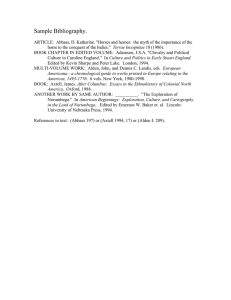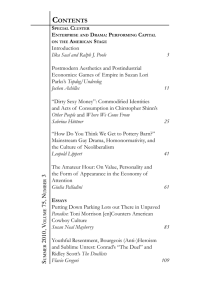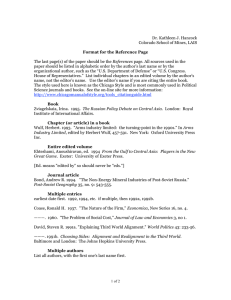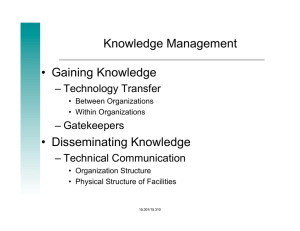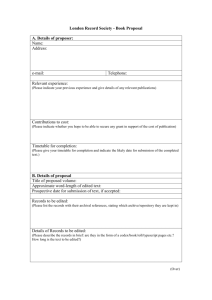11.481J / 1.284J / ESD.192J Analyzing and Accounting for Regional...
advertisement
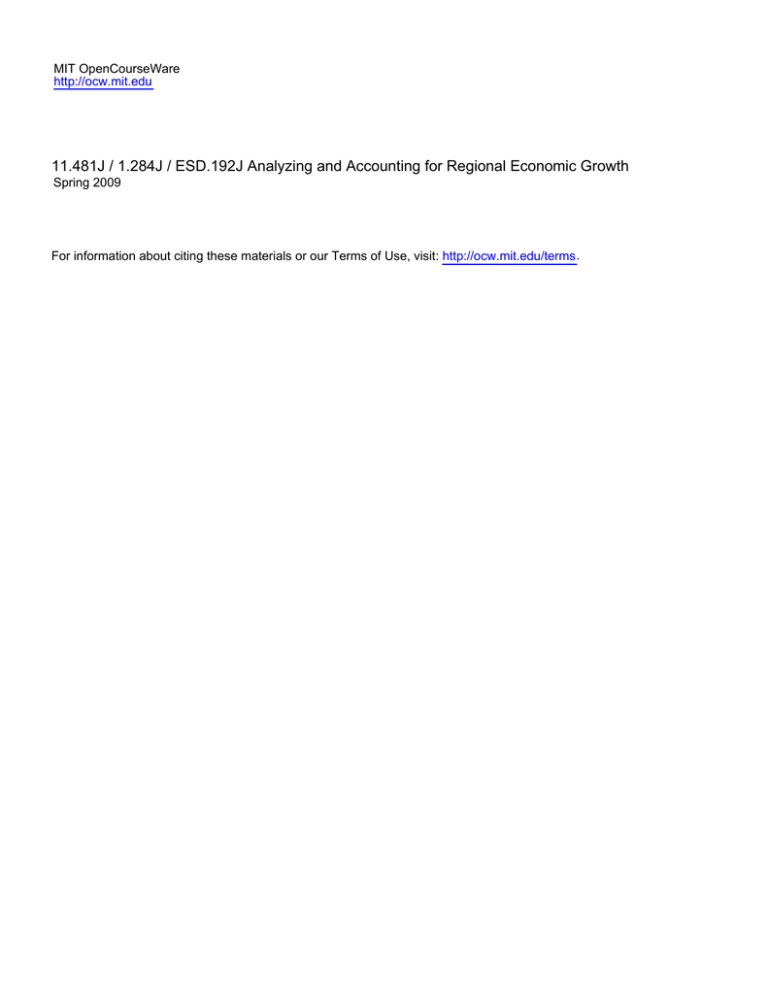
MIT OpenCourseWare http://ocw.mit.edu 11.481J / 1.284J / ESD.192J Analyzing and Accounting for Regional Economic Growth Spring 2009 For information about citing these materials or our Terms of Use, visit: http://ocw.mit.edu/terms. 11.481J, 1.284J, ESD.192J SUGGESTED READINGS I. INTRODUCTION Albert O. Hirschman. 1958. The Strategy of Economic Development. New Haven, CT: Yale University Press, pp. 50-75. Ann R. Markusen. 2007. Reining in the Competition for Capital. Kalamazoo, MI: W.E. Upjohn Institute for Employment Research. Ann R. Markusen. 1987. Regions: The Economics and Politics of Territory. Totowa, NJ: Rowman & Littlefield, Publishers, pp. 249-266. John R. Meyer. 1968. "Regional Economics: A Survey." In Regional Analysis, edited by L. Needleman. Harmondsworth, England: Penguin Books, Ltd., pp. 19-60. Kenichi Ohmae. 1995. "Putting Global Logic First," Harvard Business Review, JanuaryFebruary: 119-125. [note: p. 121 is not part of article.] Harry W. Richardson. 1978. "The State of Regional Economics: A Survey Article,” International Regional Science Review, 3 (1) (Fall): 1-48. II. REGIONAL ECONOMIC THEORIES II.A. Neoclassical Regional Growth and Orthodox Location Theories—Part I William Alonso. 1975. "Location Theory." In Regional Policy, edited by John Friedmann and William Alonso. Cambridge, MA: The MIT Press, pp. 35-63. Glenn Ellison, and Edward L. Glaeser. 1997. “Geographic Concentration in U.S. Manufacturing Industries: A Dartboard Approach,” Journal of Political Economy, 105 (5): 889-921. Gillian Hart. 1989. "The Growth Linkages Controversy: Some Lessons from the Muda Case." The Journal of Development, 25 (4): 571-575. E.M. Hoover and F. Giarriantani. 1984. An Introduction to Regional Economics. New York: Alfred A. Knopf, pp. 303-345. Douglass C. North. 1975. "Location Theory and Regional Economic Growth." In Regional Policy, edited by John Friedmann and William Alonso. Cambridge, MA: The MIT Press, pp. 332-347. John B. Parr. 1973. "Growth Poles, Regional Development, and Central Place Theory," Papers of the Regional Science Association, 31 (1): 173-212. Karen R. Polenske. 1988. "Growth-Pole Theory and Strategy Reconsidered: Domination, Linkages, and Distribution." In Regional Economic Development: Essays in Honour of François Perroux, edited by Benjamin Higgins and Donald J. Savoie. Boston: Unwin-Hyman, pp. 91-111. Harry W. Richardson. 1979. pp. 38-43, 53-70. Regional Economics. Urbana, IL: University of Illinois Press, MIT 11.481J, 1.284J, ESD.192J Page 2 of 8 Roger W. Schmenner. 1982. Making Business Location Decisions. Englewood Cliffs, NJ: Prentice-Hall, pp. 42-59. II.A Neoclassical Regional Growth and Orthodox Location Theories--Part II John Rees and Howard A. Stafford. 1986. "Theories of Regional Growth and Industrial Location: Their Relevance for Understanding High-Technology Complexes." In Technology, Regions, and Policy, edited by John Rees. Totowa, NJ: Rowman & Littlefield, pp. 23-50. Michael Storper. 1985. "Oligopoly and the Product Cycle: Essentialism in Economic Geography," Economic Geography, 61 (3): 260-282. Louis T. Wells, Jr. 1972. "The Product Life Cycle Approach." In The Product Life Cycle and International Trade, edited by Louis T. Wells, Jr. Cambridge, MA: Division of Research, Graduate School of Business Administration, Harvard University, pp. 3-33. Shahid Yusuf and Weiping Wu. 1997. "The Dynamics of Urban Growth: Location, Size, Structure, and Reforms." The Dynamics of Urban Growth in Three Chinese Cities. New York: Oxford University Press, pp. 1-17. II.B. Alternative Regional Growth and Location Theories Doreen Massey. 1979. "A Critical Evaluation of Industrial Location Theory." In Spatial Analysis, Industry, and the Industrial Environment, edited by R.E. Ian Hamilton and G.J.R. Linge. Vol. I New York: John Wiley & Sons, pp. 57-72. Michael Storper and Richard Walker. 1989. The Capitalist Imperative: Territory, Technology, and Industrial Growth. Oxford, UK: Basil Blackwell, pp. 70-124. Richard Walker. 1988. " The Geographical Organization of Production Systems," Environment and Planning D: Society & Space, 6 (4): 397-408. II.C. Accounting for the Economic Base of a Region Walter Isard. 1998. “Location Analysis for Industry and Service Trades: Comparative Cost and Other Approaches.” In Methods of Interregional and Regional Analysis, edited by Walter Isard, Iwan J. Aziz, Matthew P. Drennan, Ronald E. Miller, Sidney Saltzman, and Erik Thorbecke. Brookfield, VT: Ashgate Publishing Company, pp. 7-39. Richard E. Klosterman and Yichuan Xie. 1993. "ECONBASE: Local Employment Projection." In Spreadsheet Models for Urban and Regional Analysis, edited by Richard E. Klosterman and Richard K. Brail. New Brunswick, NJ: Center for Urban Policy Research, pp. 183-204. Ann R. Markusen, Helzi Noponen, and Karl Dreissen. 1991. "International Trade, Productivity, and U.S. Regional Job Growth: A Shift-Share Interpretation," International Regional Science Review, 14 (1): 15-40. Saul Pleeter. 1980. "Methodologies of Economic Impact Analysis: An Overview." In Economic Impact Analysis: Methodology and Applications, edited by Saul Pleeter. Boston, MA: Martinus Nijhoff Publishing, pp. 7-31. MIT 11.481J, 1.284J, ESD.192J Page 3 of 8 Benjamin H. Stevens and Craig L. Moore. 1980. "A Critical Review of the Literature on Shift-Share as a Forecasting Technique," Journal of Regional Science, 20 (4): 419-437. II.D. Influence of Globalization on Factor Mobility George J. Borjas. 2005. “Native Internal Migration and the Labor Market Impact of Immigration.” Working Paper No. 11610. Cambridge, MA: National Bureau of Economic Analysis, pp. 1-64. Helmuth Cremer and Pierre Pestieau. 2003. “Factor Mobility and Redistribution: a Survey,” in Handbook of Urban and Regional Economics, Volume 4, J. V. Henderson and J. F. Thisse, eds. Michael J. Greenwood. 1975. "Research on Internal Migration in the U.S.: A Survey." Journal of Economic Literature, 13 (1): 397-433. Yutaka Horiba and Richard Kirkpatrick. 1981. "Factor Endowments, Factor Proportions, and the Allocative Efficiency of U.S. Interregional Trade," The Review of Economics and Statistics, 63 (2) (May): 178-187. R. J. Johnstone. 1986. "The State, the Region, and the Division of Labor." In Production, Work, and Territory, edited by Michael Storper and Allan J. Scott. Boston, MA: Allen and Unwin, pp. 265-280. Paul Krugman. 1991. Geography and Trade. Cambridge, MA: The MIT Press, pp. 1-34. Glenn H. Miller, Jr. 1995. "Dynamics of the U.S. Interstate Migration System, 1975-1992." Growth and Change, 26 (1) (Winter): 139-160. J. Moroney and James M. Walker. 1966. "A Regional Test of the Heckscher-Ohlin Hypothesis," Journal of Political Economy, 74 (6) (December): 573-586. Saskia Sassen. 1988. The Mobility of Labor and Capital: A Study in International Investment and Labor Flows. Cambridge, England: Cambridge University Press, pp. 12-25. Michael P. Todaro. 1997. 6th Ed. Economic Development. Reading: Addison-Wesley, pp. 419-457. II.E. Deindustrialization and Restructuring Michael H. Best. 2001. “Five Models of Technology Management.” Chapter 2, The New Competitive Advantage: The Renewal of American Industry. Oxford, England: Oxford University Press, pp. 1-26. Robert W. Crandall. 1993. Manufacturing on the Move. Washington, DC: The Brookings Institution, pp. 1-24. Florida, Richard. 1996. "Regional Creative Destruction: Production Organization, Globalization, and the Economic Transformation of the Midwest.” Economic Geography. 72 (3): 314-333. MIT 11.481J, 1.284J, ESD.192J Page 4 of 8 Bennett Harrison and Barry Bluestone. 1988. The Great U-Turn: Corporate Restructuring and the Polarizing of America. New York: Basic Books, pp. 21-75. Michael Piore and Charles Sabel. 1984. The Second Industrial Divide. New York, NY: Basic Books, pp. 165-193. Karen R. Polenske. 2004. “Competition, Collaboration, and Cooperation: an Uneasy Triangle in Networks of Firms and Regions.” Regional Studies. 38 (9): 1029-1043. Charles F. Sabel. 1989. "Flexible Specialization and the Re-emergence of Regional Economies." In Reversing Industrial Decline? edited by Paul Hirst and Jonathan Zeitlin. Oxford, UK: Berg, pp. 17-69. F. Tödtling and M. Trippl. 2004. “Like Phoenix from the Ashes? The Renewal of Clusters in Old Industrial Areas.” Urban Studies, 41: 1175–1195. II.F Agglomeration and Dispersal Economies, Part I Amy K. Glasmeier and Jeff Kibler. 1996. "Power Shift: The Rising Control of Distributors and Retailers in the Supply Chain for Manufacturing Goods." Urban Geography, 17 (8): 740757. Bennett Harrison. 1994. Lean and Mean: The Changing Landscape for Corporate Power in the Age of Flexibility. New York: Basic Books, Inc. Bernard Fingleton, Danilo Igliori, Barry Moore, and Raakhi Odreda. 2007. “Employment Growth and Cluster Dynamics of Creative Industries in Great Britain,” In Ch. 4, The Economic Geography of Innovation, edited by Karen R. Polenske, Cambridge, UK: Cambridge University Press. Borje Johansson and John M. Quigley. 2004. “Agglomeration and Networks in Spatial Economies.” Papers in Regional Science: Journal of the Regional Science Association International, 83 (1): 165-176. Edward J. Malecki. 1983. "Technology and Regional Development: A Survey," International Regional Science Review, 8 (2): 89-123. Karen R. Polenske. 2001. "Competitive Advantage of Regional Internal and External Supply Chains." In Regional Science Perspectives in Economic Analysis, Benjamin H. Stevens, edited by Michael L. Lahr and Ronald E. Miller, Amsterdam, The Netherlands: Elsevier Science, BV, pp. 259-284. Charles F. Sabel. 1997. "Constitutional Orders: Trust Building and Response to Change." Contemporary Capitalism: The Embeddedness of Institutions, edited by J. Rogers Hollingsworth and Robert Boyer. Cambridge: Cambridge University Press, pp. 154-188. II.G. Agglomeration and Dispersal Economies, Part II Ash Amin and Kevin Robbins. 1990. "Industrial Districts and Regional Development: Limits and Possibilities." and responses by Sabel, Piore, and Storper. In Industrial Districts and Inter-Firm Cooperation in Italy, edited by F. Pyke, G. Becattini, and W. Sengenberger, pp. 185-237. MIT 11.481J, 1.284J, ESD.192J Page 5 of 8 Bjørn T. Asheim. 2001. “Learning Regions as Development Coalitions: Partnership as Governance in European Workfare States?” Concepts and Transformation. International Journal of Action Research and Organizational Renewal, 6 (1) Meric S. Gertler. 2007. “Tacit Knowledge in Production Systems: How Important Is Geography?” In Ch. 5, The Economic Geography of Innovation, edited by Karen R. Polenske, Cambridge, UK: Cambridge University Press. Martin Hart-Landsberg. 1998. "Contradictions of Capitalist Industrialization in East Asia: A Critique of 'Flying Geese' Theories of Development," Economic Geography, 74 (2): 87-110. Philip McCann and D. Shefer. 2005. “Agglomeration, Economic Geography and Regional Growth. “ Papers in Regional Science, Vol. 83, No.1: 177-196 Kevin Morgan. 1997. “The Learning Region: Institutions, Innovation, and Regional Renewal.” Regional Studies, 31 (5): 491-503. Rui Baptista and Peter Swann. 1998, "Do Firms in Clusters Innovate More?" Research Policy, 27 (5): 525-540. Alfred Chandler, Jr., Peter Hagström, and Örjan Sölvell, eds. 1998, The Dynamic Firm: The Role of Technology, Strategy, Organization, and Regions. New York: Oxford University Press Andrew Sayer and Richard Walker. 1994. "Beyond Fordism and Flexibility." The New Social Economy: Reinventing the Division of Labor. Cambridge, Blackwell, pp. 191-223. Herbert Schmitz. 1989. "Flexible Specialization: A New Paradigm of Small-Scale Industrialization?" Brighton, England: University of Sussex, Institute of Development Studies. II.H. Spatial Dispersal of Innovation, (Theories of Information Technology and Communication) Part I Allen J. Scott. 1998. Regions and the World Economy, New York, Oxford University Press, pp. 47-73. Bjørn T. Asheim and Sverre J. Herstad. Forthcoming. “Regional Clusters Under International Duress: Between Local Learning and Global Corporations.” Oslo, Norway: Centre for Technology, Innovation, and Culture. Bjørn T. Asheim and Arne Isaksen. 2002. “Regional Innovation Systems: The Integration of ‘Sticky’ and Global ‘Ubiquitous’ Knowledge.” Journal of Technology Transfer 27 (1): 7786. David B. Audretsch and Maryann P. Feldman. 2003. “Knowledge Spillovers and the Geography of Innovation,” in Handbook of Urban and Regional Economics, Vol. 4, J.V. Henderson and J.F. Thisse, eds., pp. 1-41. David Campbell and Donald Harris. 1993. "Flexibility in Long-Term Contractual Relationships: The Role of Cooperation," Journal of Law and Society, 20 (2) (summer): 166191. MIT 11.481J, 1.284J, ESD.192J Page 6 of 8 Elinor Ostrom. 1990. Governing the Commons: The Evolution of Institutions for Collective Action. Cambridge, UK: Cambridge University Press, Chapter 2, pp. 29-55. John H. Dunning and Khalil A. Hamdani. 1997. The New Globalism and Developing Countries. New York, NY: United Nations University Press, pp. 79-180. Karen R. Polenske. 2006. “Clustering in Space Versus Dispersing Over Space,” In the Emerging Digital Economy: Entrepreneurship, Clusters, and Policy, edited by Börje Johansson, Charlie Karlsson and Roger Stough. Springer Berlin Heidelberg, pp. 35-54. Dani Rodrik 1997. Has Globalization Gone Too Far? International Economics, pp. 1-48. Washington, DC: Institute for Charles F. Sabel. 1992. "Studied Trust: Building New Forms of Co-operation in a Volatile Economy." In Industrial Districts and Local Economic Regeneration, edited by Frank Pyke and Werner Sengenberger. Geneva: Institute for Labour Studies, pp. 215-250. Michael Storper and Allen J. Scott. 1995. “The Wealth of Regions: Market Forces and Policy Imperatives in Local and Global Context.” Futures, 27 (5): 505-526. Michael Storper. 1997. The Regional World. New York, NY: The Guilford Press, pp. 26-56. II.I. Spatial Dispersal of Innovation (Measurement Issues), Part II [no suggested readings] II.J. Spatial Dispersal of Innovation (Measurement Issues Continued), Part III [no suggested readings] III REGIONAL, INTERREGIONAL, AND MULTIREGIONAL INPUT-OUTPUT ACCOUNTS III.A. Overview of Economic Accounts Stan Czamanski. 1973. Regional and Interregional Social Accounting. Lexington, MA: D.C. Heath and Company, Lexington Books, Chapters 1-3. Hazel Henderson. 1996. "What's Next in the Great Debate About Measuring Wealth and Progress?" Challenge (November-December), pp. 50-56. Geoffrey J.D. Hewings. 1985. Regional Input-Output Analysis. Beverly Hills, CA: Sage Publications, pp. 9-37. William A. Schaffer. 1998. A Survey of Regional Economic Models. Atlanta, GA: Georgia Institute of Technology, pp. 48-83. http://www.rri.wvu.edu/WebBook/Schaffer/chap03.html#Heading25 III.B. Regional and Multiregional Accounting Structures: Parts I and II MIT 11.481J, 1.284J, ESD.192J Page 7 of 8 Leon N. Moses. 1955. "The Stability of Interregional Trading Patterns and Input-Output Analysis," American Economic Review, 45 (5) (December): 803-832. Harry Richardson. 1977. Regional Economics. Urbana, IL: University of Illinois Press, pp. 179-184. Ronald E. Miller and Peter D. Blair. 1985. Input-Output Analysis: Foundations and Extensions. Chapter 3. Englewood Cliffs, NJ: Prentice Hall, Inc., pp. 45-148, 236-265. III.C. Uses of Accounts: Linkage Analyses and Forecasting Victor Bulmer-Thomas. 1982. Input-Output Analysis in Developing Countries. New York: John Wiley & Sons Ltd, pp. 190-202. III.D Uses of Accounts: Social Accounting Matrices, Social and Environmental Multipliers Norman J. Glickman. 1977. Econometric Analysis of Regional Systems: Explorations in Model Building and Policy Analysis. New York: Academic Press, pp. 37-73. Joy E. Hecht. 2005. Chapters 4 & 5. National Environmental Accounting: Bridging the Gap between Ecology and Economy. Washington, DC: Resources for the Future, pp. 53-89. Benjamin B. King. 1985. "What is a SAM?" In Social Accounting Matrices: A Basis for Planning, edited by Graham Pyatt and Jeffery I. Round. Washington, DC: The World Bank, pp. 17-51. Bureau of Economic Analysis, 1997. Regional Multipliers: A User Handbook of the Regional Input-Output Modeling System (RIMS II). U.S. Department of Commerce; Bureau of Economic Analysis. Ronald E. Kutscher. 1991. "New BLS Projections: Findings and Implications," Monthly Labor Review (November), pp. 3-12. Victor Bulmer-Thomas. 1982. Input-Output Analysis in Developing Countries: Sources, Methods, and Applications. New York: John Wiley & Sons, Ltd., pp. 139-155. III.E. Accounting Issues and Concepts Boundaries: Imputations and Underground Economy Portes, A., M. Castells, and L. Benton. 1989. “World Underneath: The Origins, Dynamics, and Effects of the Informal Economy”. In The Informal Economy: Studies in Advanced and Less Developed Countries. Edited by A. Portes, M. Castells, and L. Benton. Johns Hopkins, Baltimore. Edgar L. Feige. 1990. "Defining and Estimating Underground and Informal Economies: The New Institutional Economics Approach." World Development, 8 (7): 989-1002. Victor Bulmer-Thomas. 1982. Input-Output Analysis in Developing Countries: Sources, Methods, and Applications. New York: John Wiley & Sons, Ltd., pp. 139-155. MIT 11.481J, 1.284J, ESD.192J Page 8 of 8 Carol Carson. 1984. "The Underground Economy: An Introduction," Survey of Current Business, 64 (5) (May): 21-37. Steven Landefeld and Barbara M. Fraumeni. 2001. “Measuring the New Economy” Survey of Current Business, March 2001, pp. 23-40. III.F. Price Indices Dean Baker. 1996. "The Overstated CPI--Can it Really be True?" Challenge (SeptemberOctober), pp. 26-33. Charles Mason and Clifford Butler. 1987. "New Basket of Goods and Services being Priced in Revised CPI," Monthly Labor Review, 110 (1): 3-22. Dimitri B. Papdimitriou and L. Randall Wray. 1996. "The Consumer Price Index as a Target of Monetary Policy." Challenge (September -October), pp. 18-24. IV. ANALYTICS OF REGIONAL ECONOMICS IV.A. Shift-Share Analysis Richard E. Klosterman, and Yichun Xie. 1993. "Shift-Share: Local Employment Projection." In Spreadsheet Models for Urban and Regional Analysis, edited by Richard E. Klosterman and Richard K. Brail. New Brunswick, NJ: Center for Urban Policy Research, pp. 183-204. Ann R. Markusen, Helzi Noponen, and Karl Dreissen. 1991. "International Trade, Productivity, and U.S. Regional Job Growth: A Shift-Share Interpretation," International Regional Science Review, 14 (1): 15-40. IV.B. Determinants of City and Regional Growth A. Alesina, and D. Rodrik 1994. “Distribution Politics and Economic Growth,” The Quarterly Journal of Economics, 109, 456-490. P. Beeson, D. DeJong, and W. Troesken. 2001. “Population Growth in U.S. Counties, 18401990,” Regional Science and Urban Economics, 31: 669-699. Kelvin M. Pollard. 2005. Population Growth and Distribution in Appalachia: New Realities. Washington, DC: Appalachian Regional Commission. IV.C. Regional Economics and Energy [no suggested readings] IV.D. Regional Economic Disasters [no suggested readings]
